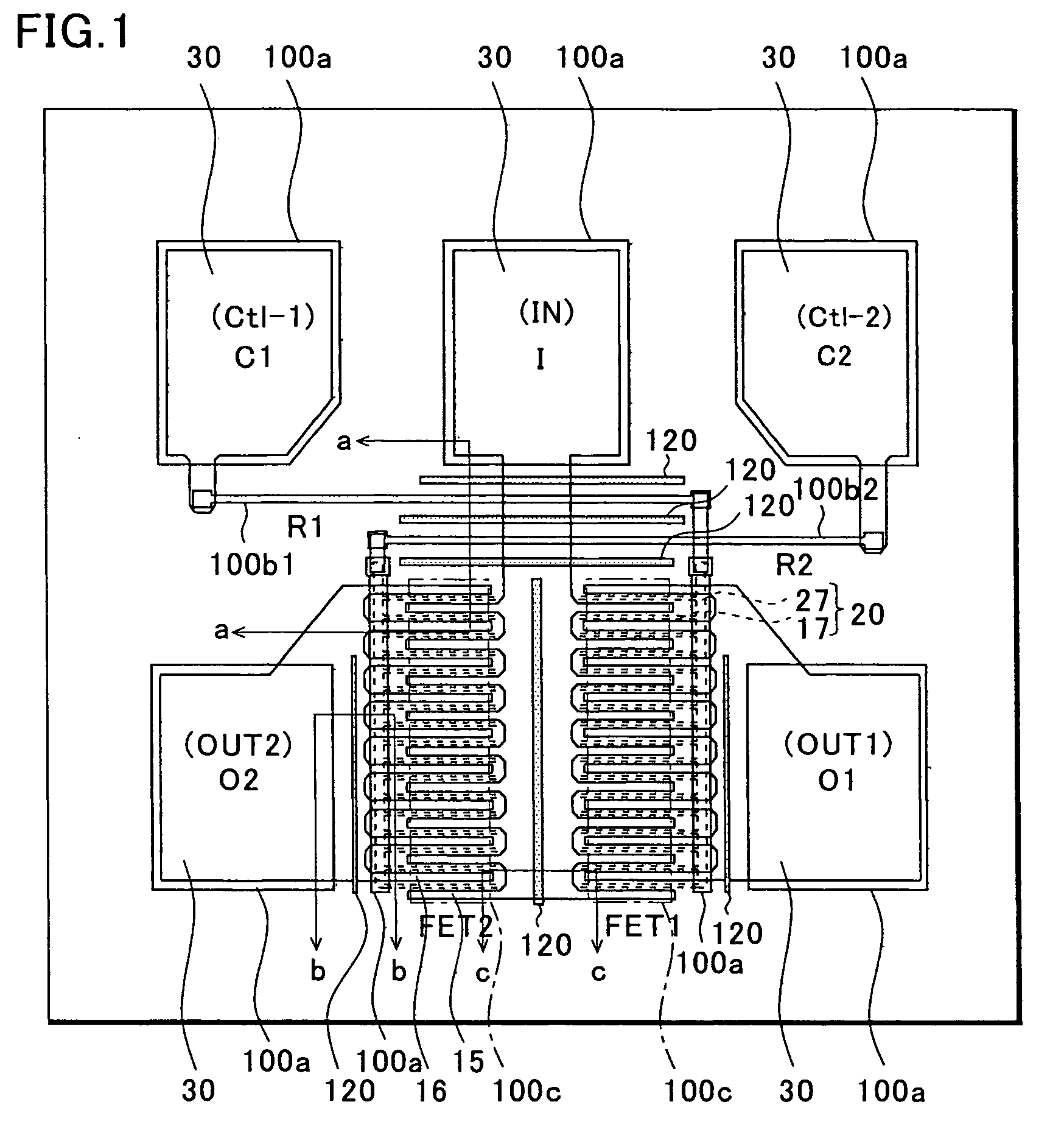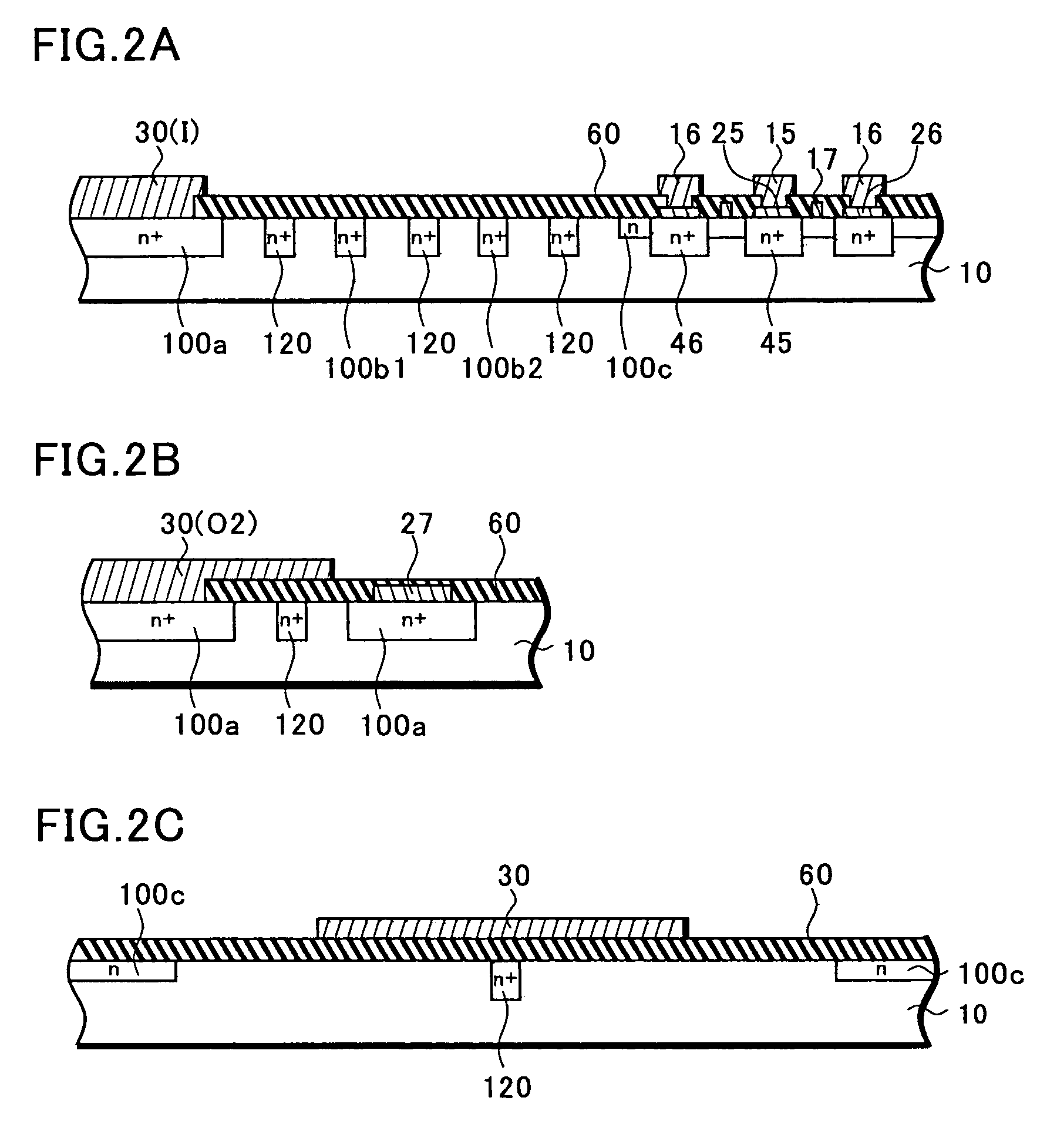Semiconductor device
a technology of mmic and fets, applied in the field of mmiconductor devices, can solve the problems of increased insertion loss, inability to observe and inability to detect the addition of insertion loss
- Summary
- Abstract
- Description
- Claims
- Application Information
AI Technical Summary
Benefits of technology
Problems solved by technology
Method used
Image
Examples
first embodiment
[0038] First, using FIGS. 1 to 2C, the present invention will be described by taking as an example an SPDT switch circuit device using GaAs MESFETs.
[0039]FIG. 1 is a plan view showing the first embodiment. The circuit diagram thereof is the same as that of FIG. 10B, and therefore omitted. The source electrodes (or drain electrodes) of first and second FETs FET1 and FET2 are connected to a common input terminal IN. The gate electrodes of the FET1 and FET2 are connected to first and second control terminals Ctl-1 and Ctl-2 through resistors R1 and R2, respectively. Further, the drain electrodes (or source electrodes) of the FET1 and FET2 are connected to first and second output terminals OUT1 and OUT2, respectively. Control signals which are applied to the first and second control terminals Ctl-1 and Ctl-2 are complementary signals. Of the FET1 and FET2, one to which an H-level signal is applied is turned on, whereby an input high-frequency signal entering the common input terminal IN...
second embodiment
[0064] Next, the present invention will be described with reference to FIG. 3.
[0065] The second embodiment is the case where basic devices are HEMTs, and is provided with a pattern similar to that for the case of GaAs FETs shown in the first embodiment. That is, a plan view thereof is similar to that of FIG. 1 and therefore will not be described. A description will be given with reference to the cross-sectional views of FIGS. 3A to 3C. Note that FIG. 3A is a cross-sectional view taken along the a-a line of FIG. 1, FIG. 3B is a cross-sectional view taken along the b-b line of FIG. 1, and FIG. 3C is a cross-sectional view taken along the c-c line of FIG. 1.
[0066] In a HEMT, an undoped buffer layer 32 is deposited on a semi-insulating GaAs substrate 31. In most of the relevant cases, the buffer layer is formed of a plurality of layers. Further, an n+ type AlGaAs layer 33 to serve as an electron-supplying layer, an undoped InGaAs layer 35 to serve as a channel (electron transit) layer,...
fourth embodiment
[0108] Furthermore, a fourth embodiment will be described with reference to FIGS. 8 and 9.
[0109] The fourth embodiment is a switch circuit device for high-power application in which a plurality of stages of FETs are connected in series.
[0110]FIG. 8 is a circuit diagram showing one example of a multistage-connection compound semiconductor switch circuit device. This switch circuit device is also an SPDT switch. There are five external terminals: a common input terminal IN, first and second output terminals OUT1 and OUT2, and first and second control terminals Ctl-1 and Ctl-2.
[0111] As shown in FIG. 8, the switch circuit device includes first and second FET groups F1 and F2, each of which has, for example, two stages of FETs connected in series. Further, a source electrode (or a drain electrode) of an FET FET1-1 of the first FET group F1 and a source electrode (or a drain electrode) of an FET FET2-1 of the second FET group F2 are connected to the common input terminal IN. The gate e...
PUM
 Login to View More
Login to View More Abstract
Description
Claims
Application Information
 Login to View More
Login to View More - R&D
- Intellectual Property
- Life Sciences
- Materials
- Tech Scout
- Unparalleled Data Quality
- Higher Quality Content
- 60% Fewer Hallucinations
Browse by: Latest US Patents, China's latest patents, Technical Efficacy Thesaurus, Application Domain, Technology Topic, Popular Technical Reports.
© 2025 PatSnap. All rights reserved.Legal|Privacy policy|Modern Slavery Act Transparency Statement|Sitemap|About US| Contact US: help@patsnap.com



